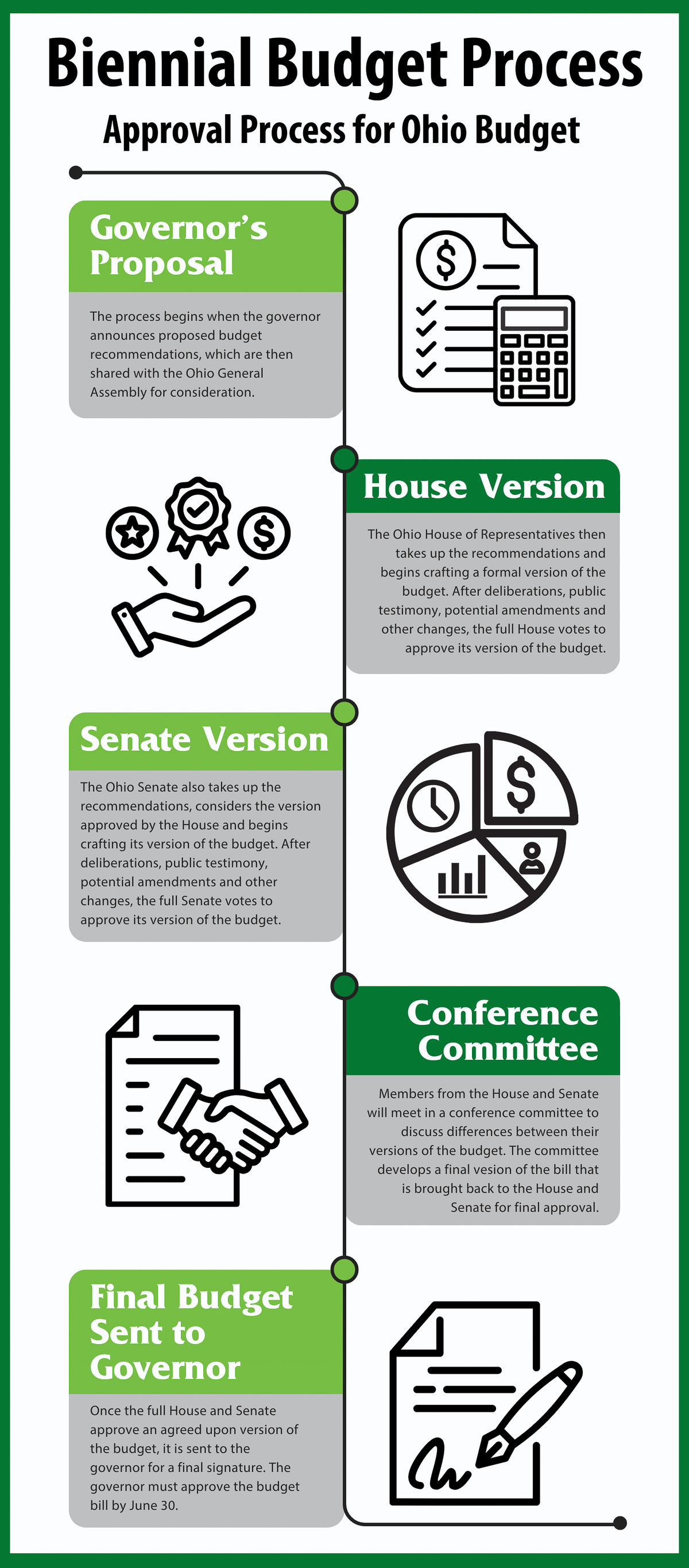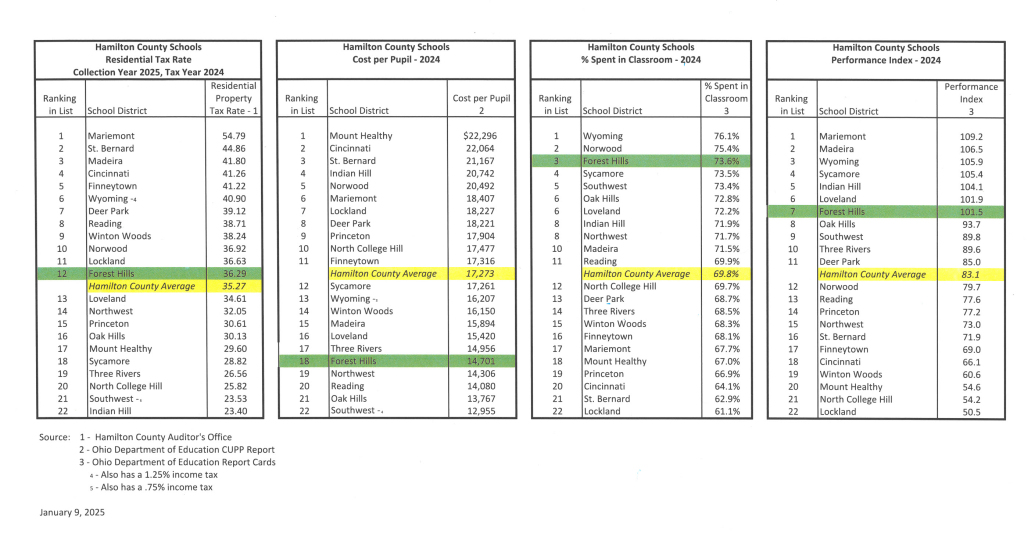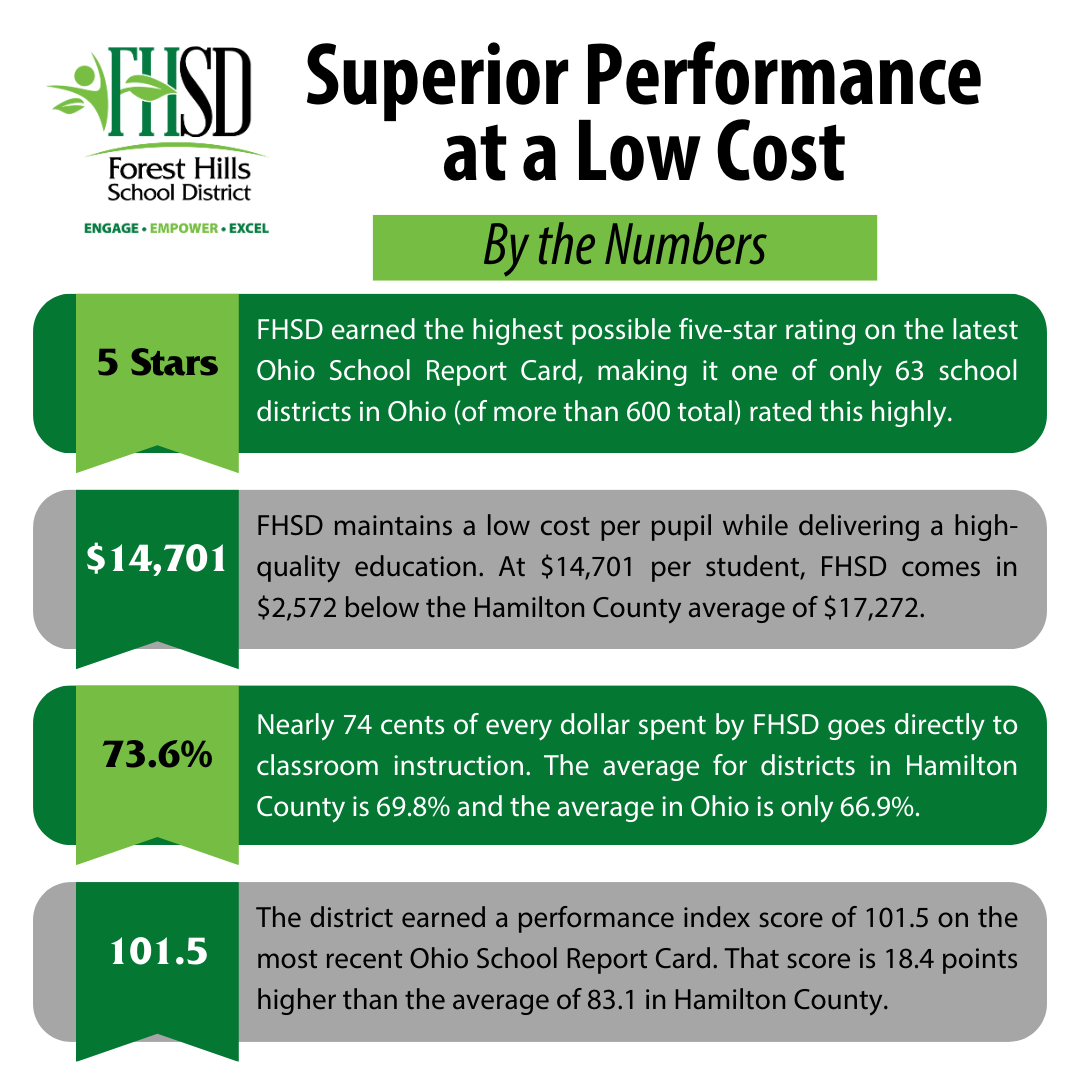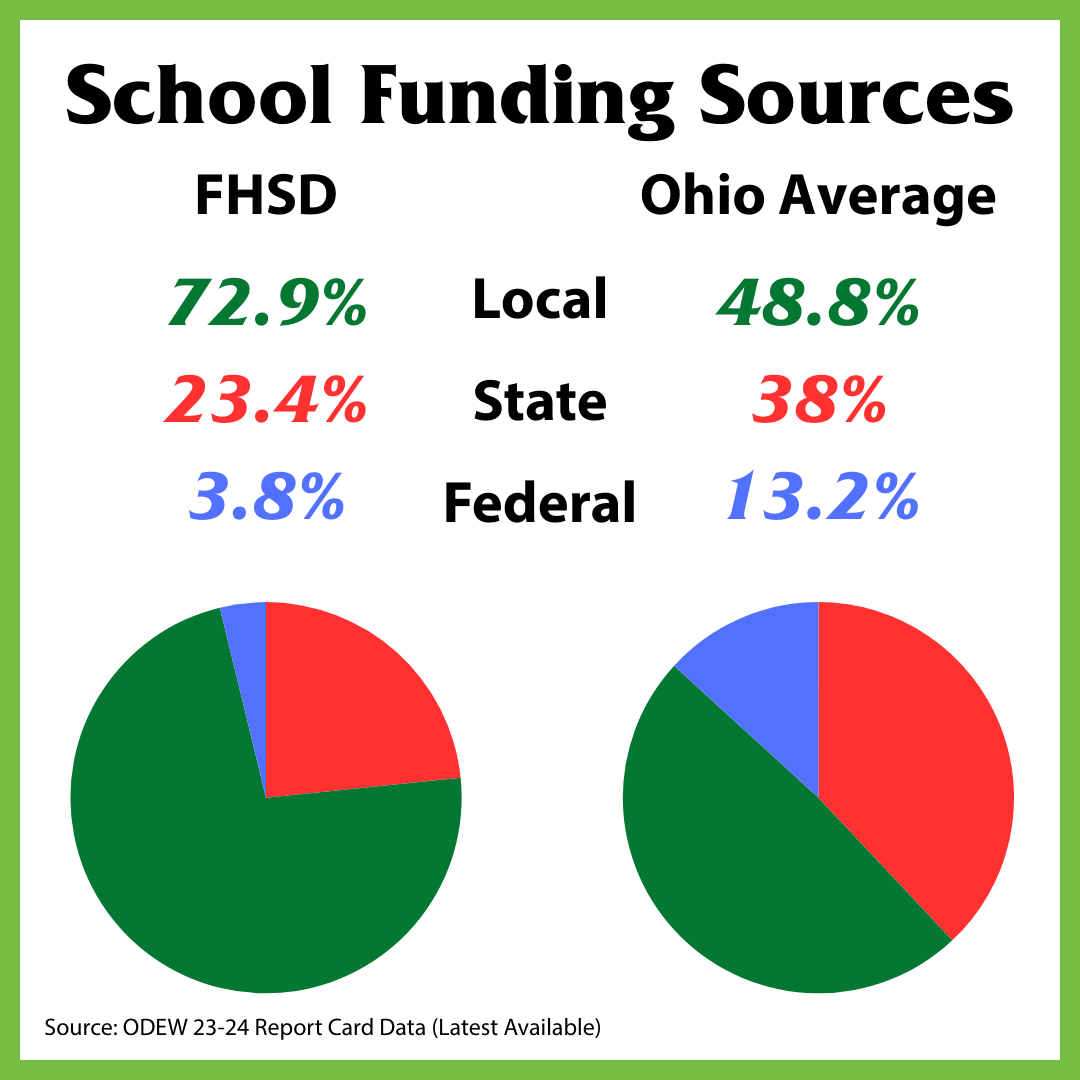School Funding

Ohio Biennial Budget Need-to-Know
Lawmakers in Ohio are currently drafting the next two-year state budget, making proposals and considering changes to funding that could have an impact on public education and other programs across the state. This process involves Governor Mike DeWine’s office, the Ohio House of Representatives and the Ohio Senate, with a deadline to approve a final budget by June 30, 2025.
The initial budget proposal from the Governor would result in significant decreases in state funding for Forest Hills School District, placing even more of the burden on local taxpayers to pay for public education in our community. Based on this initial proposal, FHSD could see a reduction of approximately $850,000 over the next two fiscal years based on decreased “guarantee” funds.
The Forest Hills Board of Education, Superintendent and Treasurer have been working diligently to advocate for our school district during this process, and they encourage community members to get involved by sharing their perspective with lawmakers and helping to educate neighbors about the impact of state funding on FHSD’s bottom line. While the district has a long track record of high achievement and superior performance at a below-average cost, any reduction in funds from the state level would negatively impact the district’s financial health.
It is critical that voices from our community are heard during this budget process. Please consider sharing your perspective with state lawmakers by calling, emailing or sending a letter to their offices.
Why is this important? With less financial support from the state, local taxpayers must shoulder a greater share of school funding.
Public education in Ohio is a shared state and local responsibility. State funding from revenue like income taxes, lottery profits and other sources is shared with public school districts to support the education of students. For FHSD, the majority of local funds comes from property taxes paid by homeowners. If the state decides to reduce funding for FHSD or fails to keep up with rising costs due to inflation, the district will need to rely more heavily on local taxpayers. This will result in either larger and more frequent property tax levy requests or a reduction in academic programming for students to help reduce costs.
Funding Impact of Current Budget Proposals
- Governor Mike DeWine (February 3 proposal)
- $850,003 estimated reduction in “guarantee funding” for FHSD over the two-year budget. The total reduction over the next five-year forecast would be $2.8 million.
- No update to base cost inputs for the Fair School Funding Plan from 2022 levels, which negatively impacts the funding calculation by relying on outdated values.
- Ohio House of Representatives (April 9 version approved by House)
- $319,190 increase primarily in “guarantee funding” for FHSD over the two-year budget. This equates to a .7% increase in year one and a .4% increase in year two, which does not keep up with rising costs due to inflation.
- Places the Fair School Funding Plan on hold and does not continue with year five and year six of implementation.
- Includes a provision to cap school district cash balances at 30% and require schools to return excess balances to taxpayers. This measure goes against the funding levels approved by local taxpayers and could result in more frequent tax levy requests by limiting a district's ability to properly execute long-term financial plans.
Key Priorities for FHSD
- Protect the “Guarantee”: Based on the initial proposal by Governor DeWine that reduces the guarantee funding levels, FHSD would lose approximately $850,000 over the next two fiscal years. Over the span of the next five-year forecast, the district could see a reduction of approximately $2.8 million.
- Fully Implement the Fair School Funding Plan: FHSD is asking state lawmakers to fulfill their commitment to the bipartisan Fair School Funding Plan by continuing its implementation with updated base cost inputs. Without updating these inputs, FHSD and other districts will lose money because the funding formula would not account for inflationary increases in those costs.
- Increase the State Share Minimum: The State of Ohio currently sets the minimum per-pupil state share of the base cost at 10%. FHSD currently receives the minimum level of funding, and is joining other school districts to ask lawmakers to increase the minimum state share to at least 20% to ensure that public education remains a shared state and local responsibility.
How to Share Your Voice
If you are interested in sending a message to your state representative, senator or other lawmakers involved in the budget process, here is some helpful information to consider.
What to Say
- Introduce Yourself: Provide your name and your connection to FHSD (parent, student, staff member, community member).
- Why This Matters to You: Share your unique perspective. If you agree with the following, you could explain why you support FHSD, what concerns you about funding cuts for the district and why you believe that would have a negative impact on children and our community.
- Specific Call to Action: Ask the lawmaker(s) to take specific action that you would like to see. This could include the key FHSD priorities listed above, like protecting the “guarantee”, fully implementing the Fair School Funding Plan with updated base cost inputs and increasing the state share minimum to 20%.
- Thank You: Consider thanking the lawmakers for their work in Columbus, their service to our community and their willingness to hear from members of the public about these topics.
Who to Contact
Click here for a list of state lawmakers you may consider contacting to share your perspective on school funding during the budget process.
Demonstrating Superior Performance at a Low Cost
The chart below illustrates how FHSD compares to other school districts in Hamilton County in multiple areas. While the district's residential tax rate is in line with the county average and the cost per pupil is far below average, FHSD has earned one of the top scores on the state's performance index (measuring academic performance levels of students in grades 3-12). The district is proud to report that 73.6% of funds are spent directly on classroom instruction, demonstrating further commitment to fiscal responsibility and educational outcomes.
FHSD is able to achieve these outcomes while receiving a smaller portion of its overall funding from the state of Ohio. While state funding accounts for 38% of total dolalrs for the average school district in Ohio, it only makes up 23.4% of FHSD's funding sources.
Frequently Asked Questions
Please click on the questions below to learn more about school funding in Ohio.
What is the Fair School Funding Plan?
Ohio lawmakers enacted the Fair School Funding Plan in 2021 with bipartisan support. The initiative was developed by legislators in coordination with school district leaders and expert practitioners and takes into account student needs by considering factors like appropriate class sizes, student support services and educational technology. The plan aims to treat taxpayers and school districts fairly based on a community’s ability to raise local funds.
The implementation of the Fair School Funding Plan formula represents a move toward the equitable and adequate funding of Ohio’s schools.
What is the “Guarantee” in Ohio School Funding?
In Ohio school funding, the "guarantee" refers to a system where districts receive a minimum level of state funding, even if their state funding is calculated to be lower due to declining enrollment or increased property values. This aspect of the Fair School Funding Plan ensures that schools don't experience sudden drops in funding and can still operate, especially since they have fixed costs that can't be easily adjusted.
What is the “State Share Minimum”?
This figure represents the minimum share of per-pupil costs that the state agrees to fund for all school districts. FHSD currently receives the 10% minimum amount, but it is important to note that this applies to the Fair School Funding Plan formula only. There are other state grants and tax funding that is received outside of the formula. Despite this, FHSD receives a far smaller portion of its overall funding from the state of Ohio. According to ODEW School Report Card Data, only 23.4% of FHSD’s funding comes from the state, whereas the average Ohio school district receives 38% of its funding this way.
What are the Base Cost Inputs and Why Are They Important?
Base cost inputs are utilized in the Fair School Funding Plan formula to help the state determine how much it costs to educate each child and what is required for each district to operate. If those inputs are not adjusted for inflation, the calculation will not match the current reality facing schools across the state and the amount of state funding will similarly fall short and increase the burden on local taxpayers.
Some factors considered for the base cost inputs (not an exhaustive list):
- Instructional costs (including teacher salaries and benefits)
- Instructional support costs
- Co-curriculars
- Safety and security
- Basic social and emotional support
- Technology and devices
- Network/Internet
- School leadership and support (principal and other personnel, facilities and supplies)
- District leadership (including central office staff)




